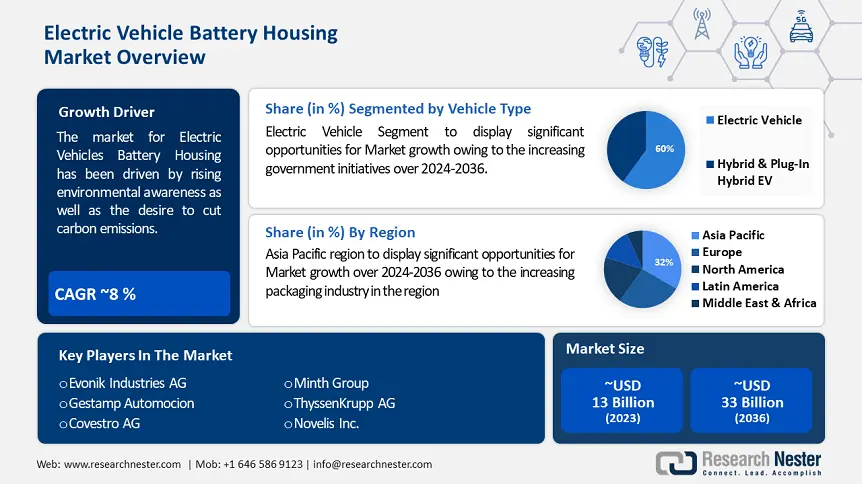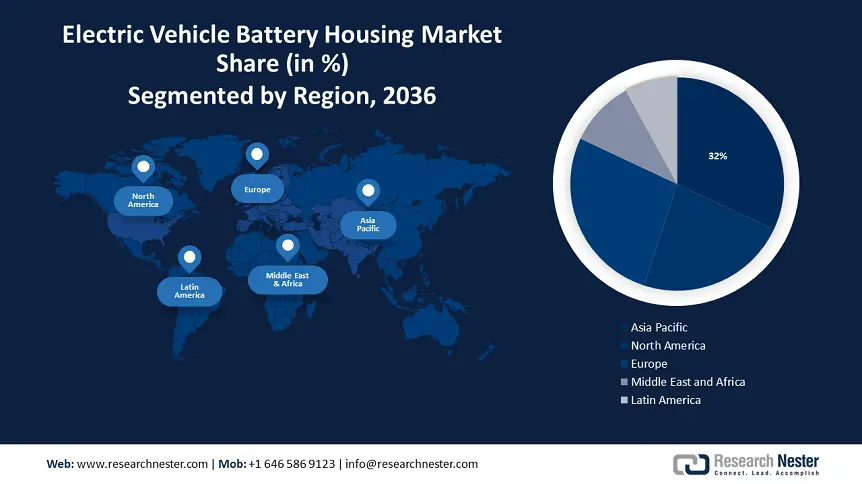
Electric Vehicle Battery Housing Market size is expected to cross USD 33 Billion by the end of 2036, growing at a CAGR of 8% during the forecast period, i.e., 2024-2036. In the year 2023, the industry size of electric vehicle battery housing was USD 13 Billion. The market for electric vehicles battery housing has been driven by rising environmental awareness as well as the desire to cut carbon emissions. Every year, a typical passenger car emits 4.6 metric tons of CO2. This assumes that the average gas-powered vehicle on the road currently gets about 22.2 mpg and covers 11,500 miles per year. For every gallon of gasoline used, about 8,887 grams of CO2 are created.
In addition to these, policies & incentives from the government will be crucial in determining how the EV battery housing industry develops. Globally, a large number of governments are putting laws and incentives into place to encourage the use of electric vehicles. Subsidies, tax breaks, and legislative initiatives are some of the strategies used to lessen reliance on cars using conventional internal combustion engines. Over the next few years, there will be a major increase in demand for EV batteries and associated components, such as battery housing, as more automakers make investments in electric vehicle technology.

Growth Drivers
Challenges
|
Base Year |
2023 |
|
Forecast Year |
2024-2036 |
|
CAGR |
~ 8% |
|
Base Year Market Size (2023) |
~ USD 13 Billion |
|
Forecast Year Market Size (2036) |
~ USD 33 Billion |
|
Regional Scope |
|
Vehicle Type (Electric Vehicle, Hybrid & Plug-In Hybrid EV)
Based on vehicle type, electric vehicle segment is anticipated to hold 60% share of the global electric vehicle (EV) battery housing market by 2036. Throughout the world governments is putting in place incentives like tax breaks and subsidies to entice people and companies to select electric cars, creating a thriving market. From 2017 to 2022, the number of electric vehicle sales increased from approximately 1 million to over 10 million in just 5 years. The previous five-year period from 2012 to 2017 demonstrated the exponential nature of EV sales growth, as EV sales increased from approximately 100,000 to one million. Furthermore, improvements in battery technology, which provide increased economy and performance, help explain why electric vehicles are becoming more and more popular in a variety of markets. Together, these initiatives seek to solve environmental issues, lower carbon emissions, and build a more sustainable transportation sector. Since the transportation sector contributes more than 15% of all energy-related emissions worldwide, electric vehicles are essential to the decarbonization of this industry.
Material (Aluminium, Steel, Magnesium, Glass Fiber-Reinforced Polymer, Carbon Fiber Reinforced Polymer)
Based on material, carbon fiber reinforced polymer segment is anticipated to hold 35% share of the global electric vehicle battery housing market by 2036. because of its attractive qualities. The exceptional strength and light weight that CFRP provides increases the overall efficiency and range of electric cars. The material's remarkable corrosion resistance and endurance add to battery systems' lifespan. Furthermore, CFRP's resistance to impact improves EV safety. The need for CFRP-based EV battery housing is only growing as the automotive industry places a greater emphasis on sustainability, efficiency, and performance. Sales of electric vehicles surpassed 10 million worldwide in 2022.
Our in-depth analysis of the global market includes the following segments:
|
Form |
|
|
Vehicle Type |
|
|
Cell Format Type |
|
|
Application |
|
|
Material |
|
APAC Market Forecast
Electric vehicle (EV) battery housing market in Asia Pacific region is estimated to hold largest revenue share of about 32% during the forecast period. Concerns regarding pollution and air quality have grown as a result of the fast urbanization of many Asian cities. The World Health Organization (WHO) considers the air that about 90% of people in the Asia-Pacific area frequently breathe to be hazardous. A center for manufacturing know-how and technical innovation is the Asia Pacific area. China, Japan, and South Korea have been major players in the development of sophisticated battery technology and EV battery housing due to their leadership positions in these areas and their manufacturing capabilities.
Europe Market Statistics
Electric vehicle battery housing market in Europe region is projected to hold second largest revenue share of about 27% during the forecast period. Europe has the second-largest market share because the continent was a pioneer in the use of electric cars. Due to manufacturers' significant investments in the production of electric vehicles, the manufacturing of EV battery packs and housing has become more innovative and widely used. European businesses have been actively involved in the development of cutting-edge battery technology, management safety, and the material used to house electric vehicles (EVs). The need for battery housing for electric vehicles is fueled by such advances.



Author Credits: Harshita Srivastava, Saima Khursheed
FREE Sample Copy includes market overview, growth trends, statistical charts & tables, forecast estimates, and much more.
Have questions before ordering this report?